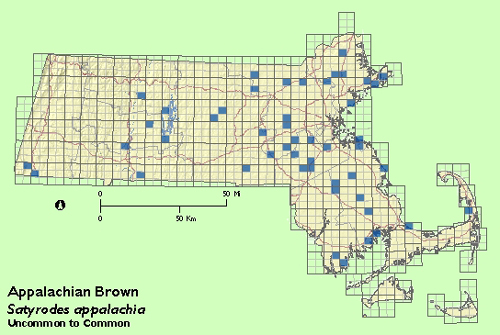Find a Butterfly
Appalachian Brown
Satyrodes appalachia
Named
R. L. Chermock, 1947

Taxonomy & Nomenclature
This species and S. eurydice were considered to be the same species until 1970 when Carde, Shapiro, and Clench published information showing that the two were actually sibling species.
Identification
Wingspan: 1 5/8-2". Similar to Eyed Brown, (S. eurydice), however, the submarginal forewing spots below are usually unequal in size and the postmedian line on the hindwing below is typically wavy, lacking the sharp indentations of eurydice. A violet hue is sometimes present on the underwing surfaces. See also Habitat below and the discussion under "Identification" in the Eyed Brown account.
Distribution
Minnesota east through southern Ontario and Quebec and central New England and south to northeastern Mississippi and northern Alabama with an isolated population in northern and central peninsular Florida (Opler, 1992). In New England from southern Vermont and New Hampshire south.
Status in Massachusetts
Uncommon to fairly common in eastern and southeastern Massachusetts although no records were obtained from the coastal islands. Uncommon in central and southwestern sections of the state. Not recorded from the central and northern portions of western Massachusetts during the Atlas. Maxima: 25, 10 August 1986, Sharon (Norfolk Co.).

Flight Period in Massachusetts
One flight: late June through August. Extreme dates: 13 June 1987, E. Longmeadow (Hampden Co.), K. Parker; and 3 September 1988, Chelmsford (Middlesex Co.), J. Center.
Larval Food Plants
Sedges, especially Tussock-sedge (Carex stricta) but possibly other (associated) species such as C. gracillima, C. lacustris, C. languinosa and Rhynchospora inundata.
Adult Food sources
Recorded once only at nectar source - Narrow-leaved Goldenrod. Like other satynds, adults prefer sap, rotting fruit and dung.

Habitat
Wooded and shrubby swamps, bogs, and other wetlands; also woodland openings and edges as well as fields and meadows adjacent to wetlands. Opler and Krizek (1984) state that this species, unlike S. eurydice, may sometimes be found in shady situations.
Life Cycle
EGG/OVIPOSITION: Eggs are laid on sedges. LARVA: Bright green with various yellow and green lateral stripes and a pair of red horn like protuberances on the head —the red restricted to the horns, and a similar pair of horns at the tail. CHRYSALIS: Chrysalis not described but see S. eurydice. During July, adults may be observed in their typical low, slow flight in various wetland areas.
Account Author
Richard K. Walton



